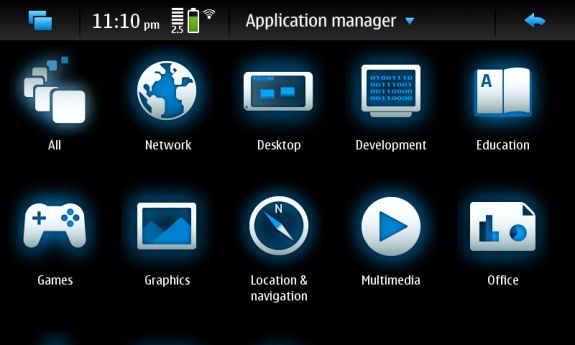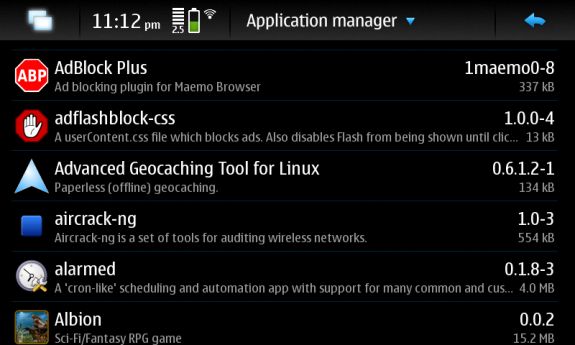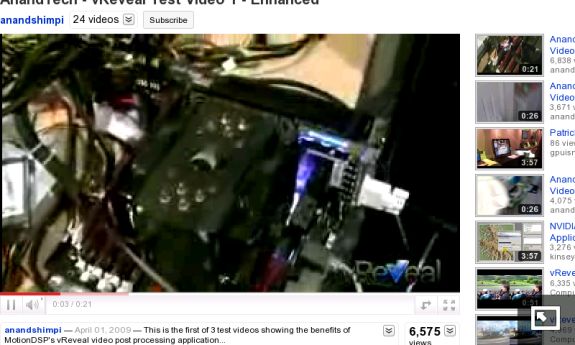Two OMAP 3430 Phones: Nokia N900 and Motorola Droid
by Brian Klug on June 10, 2010 9:29 PM EST- Posted in
- Smartphones
- N900
- Maemo
- Motorola Droid
- Droid
- MeeGo
- Android
- Mobile
Maemo's App Store
Nokia offers a simple application marketplace called the Ovi Store. In practice, this isn't anywhere near fleshed out like it should be, as launching the Ovi Store fires up the browser and takes you to the Ovi Store in the N900's browser. What's much more compelling is the Applications Manger, which is a well disguised debian package manager frontend, but admittedly polished enough to be used exclusively. You can add 'catalogs' - Nokia's parlance for repositories - from within here, and choose from a huge selection of FOSS packages that install over the air on the N900. The applications manager is every bit a graphical package manager, you can uninstall, download, and update every package on the phone.
It has categorization and feels like it was given plenty of thought, but really lacks the kind of polish other application marketplaces do on other platforms. For example - open up a big category with a couple hundred applications, and you'll find yourself scrolling for a few minutes to get to the desired one.
Take one look through the packages, and you'll know that Maemo has serious potential in the right hands - what other application marketplace has Wireshark, Kismet, Aircrack-ng and Nmap sitting unsuspectingly inside? That's awesome!
The Browser
There has been an enormous volume of debate centering around Flash on mobile platforms lately. While Android 2.2 will eventually bring full Flash 10.1 and AIR support to the entire platform, it's impressive to think about how the N900's browser on Maemo has been running full Flash 9.4 since release.
Until Froyo 2.2 brings a faster browser and Flash support to Android, it's difficult to not argue that the N900 offers the best browsing experience on the platform.
Out of box, the Mozilla-supported browser is almost all you need. There's even extension support for AdBlock Plus directly in the marketplace - and best of all? It works perfectly.
Almost all the Flash content I tried played fine, though the implementation still isn't perfect. I can understand now what Adobe means when it notes that only certain video codecs play back smoothly or are "mobile optimized."
For example, playing videos on Vimeo resulted in extremely choppy framerate and audio - the experience was unwatchable. However, YouTube videos played back perfectly, complete with audio. Hulu refuses to work on the platform, though this is likely due to the licensing issues they maintain prevent them from streaming to mobile devices. Who knows, perhaps support is just a user-agent string change away.
If the OS default browser doesn't suit you, there's also Firefox and Chromium in the marketplace.
Chromium on the N900 is very beta, but Firefox is almost good enough to supplant the normal browser. It's slower feeling, but has a very desktop feel.
















68 Comments
View All Comments
Wadzii22 - Friday, June 11, 2010 - link
Out of curiosity I ran linpack and Benchmark pi on my droid that's oc'd to 1ghzmy benchmark pi score was 1280 and linpack gives me 17.24 mflops
strikeback03 - Friday, June 11, 2010 - link
Did you run them stock? As those numbers seem to be a ~4x improvement over what is shown here, which seems odd given the ~2x increase in clockspeed.Wadzii22 - Wednesday, June 16, 2010 - link
with the phone completely stock my scores were basically the same as whats in the original article.jamyryals - Friday, June 11, 2010 - link
Please continue this type of in depth comparison with current and future hardware. PC hardware is all well and good, but it's all so fast now the mobile space is a much more interesting battle. Not to mention with how fast things are evolving there is the opportunity for a lot of content.Ratman6161 - Friday, June 11, 2010 - link
For eample, my droid purchased in early April came out of the box running at 600 MHz (though now it actually runs at up to 900 Mhz). My wife got hers in early June and hers is 600 MHz too and also came out of the box with Android 2.1 already on it.Wadzii22 - Friday, June 11, 2010 - link
For whatever reason, setcpu always sees a stock droid's max at 600, but they do run at 550. I just got a new one yesterday after bricking my old droid, it showed the same thing.CharonPDX - Friday, June 11, 2010 - link
Nokia was the originator of the "sell unsubsidized smartphones direct" model, years before Apple or Google. You could get a Nokia N80 at CompUSA completely unlocked for $800 in 2006, a year before the unsubsidized iPhone.Stas - Friday, June 11, 2010 - link
0.1 build with fixed WiFi and maps.LinPack - 12.2 (twelve point two)MFLOPS
Engadget.com loads in 20 sec (default browser)
'nuff said.
Stas - Friday, June 11, 2010 - link
forgot to mention. the CPU is at 800Mhz. I've had it up at 900Mhz with bare Android build (leaked 2.2) and the performance seems no different, but no numbers, sorry.milli - Saturday, June 12, 2010 - link
That's pretty wrong what you're saying there.Qualcomm didn't even license the A8 (nor will they ever).
What they did license is the ARMv7 instruction set (and that's a huge difference). With that they made a custom implementation of the ARMv7 architecture. (BTW Qualcomm already stated in 2005 that they're an architectural licensee for ARM’s ARMv7 instruction set)
There are many differences between Scorpion and A8.
I'll quote from a certain article since i can't say it better:
'Although Scorpion and Cortex-A8 have many similarities, based on the information released by Qualcomm, the two cores differ in a number of interesting ways. For example, while the Scorpion and Cortex-A8 NEON implementations execute the same SIMD-style instructions, Scorpion’s implementation can process128 bits of data in parallel, compared to 64 bits on Cortex-A8. Half of Scorpion’s SIMD data path can be shut down to conserve power. Scorpion’s pipeline is deeper: It has a 13-stage load/store pipeline and two integer pipelines—one of which is 10 stages and can perform simple arithmetic operations (such as adds and subtracts) while the other is 12 stages and can perform both simple and more complex arithmetic, like MACs. Scorpion also has a 23-stage floating-point/SIMD pipeline, and unlike on Cortex-A8, VFPv3 operations are pipelined. Scorpion uses a number of other microarchitectural tweaks that are intended to either boost speed or reduce power consumption. (Scorpion’s architects previously designed low-power, high-performance processors for IBM.) The core supports multiple clock and voltage domains to enable additional power savings."
"Qualcomm claims that Scorpion will have power consumption of roughly 200 mW at 600 MHz (this figure includes leakage current, though its contribution is typically minimal in low-power processes). In comparison, ARM reports on its website that a Cortex-A8 in a 65 nm LP process consumes .59 mW/MHz (excluding leakage), which translates into about 350 mW at 600 MHz."
With that said, i don't understand where the misconception about the Scorpion being an A8 started. Even Qualcomm states clearly on their own website that Scorpion is not licensed from ARM. They also state that they invested hundred of millions in creating their own core based on the ARMv7 instruction set.
I hope now all the staff from Anand will stop saying that there's an A8 inside of Snapdragon. Or maybe you should even clarify that with a small article.